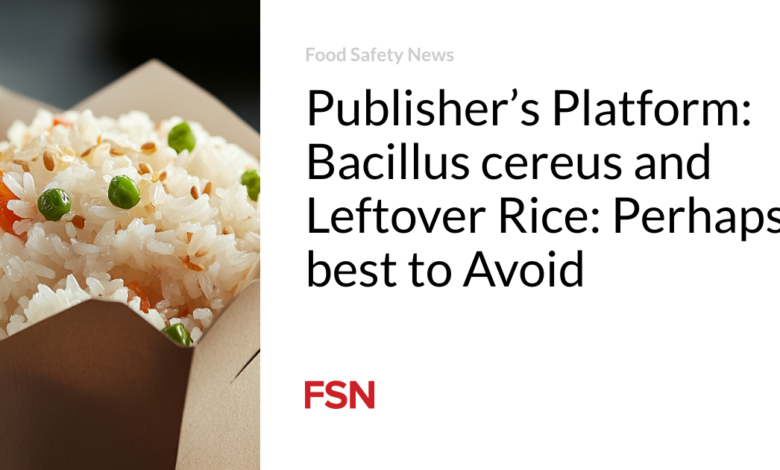Publisher’s Platform: Bacillus cereus and Leftover Rice: Perhaps best to Avoid

Food safety is a critical aspect of health, and understanding the risks associated with improper food handling and storage can prevent foodborne illnesses. One microorganism that poses a risk, especially with leftover rice, is Bacillus cereus. This article will discuss the characteristics of Bacillus cereus, the risks associated with leftover rice, and best practices to ensure food safety.
What is Bacillus cereus?
Bacillus cereus is a gram-positive, rod-shaped bacterium that is commonly found in soil, vegetation, and food. It is known for producing two types of toxins: those causing vomiting (emetic) and those causing diarrhea (diarrheal) symptoms. Bacillus cereus is a spore-forming organism, meaning it can survive in harsh conditions, including high temperatures. This resilience allows it to remain a concern in various food contexts, especially with improperly handled leftovers.
The Connection with Rice
Rice, particularly when cooked and left to cool slowly at room temperature, is a common food that can harbor Bacillus cereus. When rice is cooked, spores of Bacillus cereus can survive the cooking process. If rice is left unrefrigerated for an extended period post-cooking, the bacteria can thrive, reproduce, and produce harmful toxins. The warm, moist environment of cooked rice creates an ideal setting for bacterial growth.
Health Risks
Consumption of rice contaminated with Bacillus cereus can lead to foodborne illnesses, manifesting primarily in two forms:
1. Emetic Syndrome: This syndrome is often associated with the consumption of rice dishes, particularly fried rice. Symptoms include nausea, vomiting, and abdominal cramps, and they can occur within one to six hours of ingestion, typically attributed to the preformed toxins in the food.
2. Diarrheal Syndrome: This form usually arises 6–15 hours after consuming contaminated food. Symptoms include diarrhea, abdominal pain, and in some cases, nausea and vomiting. The illness is triggered by the ingestion of the bacteria, which then produces toxins in the intestines.
While most healthy individuals recover without severe consequences, those with compromised immune systems, pregnant women, elderly individuals, and young children may face more serious health risks.
Safe Practices for Handling Leftover Rice
To reduce the risk of Bacillus cereus contamination, it’s crucial to follow safe food handling and storage practices, especially when dealing with rice and other starchy foods:
1. Cool Rice Quickly: After cooking, rice should be cooled rapidly to minimize the time spent in the “danger zone” (40°F – 140°F or 4°C – 60°C), where bacteria tend to grow. Spread rice out in a thin layer on a baking sheet to cool quickly or divide it into smaller portions to expedite the cooling process.
2. Store Promptly: Once the rice has cooled to room temperature, it should be stored in airtight containers. Refrigerate leftovers within two hours to curtail any potential bacterial growth. Ensure your refrigerator is set below 40°F (4°C).
3. Reheat Properly: Before serving again, rice should be reheated to a minimum of 165°F (74°C). This temperature helps ensure that any potential spores are destroyed, and that the food is safe to consume.
4. Limit Storage Duration: Leftover rice should ideally be consumed within three to four days. If it is not going to be eaten within this timeframe, consider freezing it. Frozen rice can be safely stored for up to six months.
5. Avoid Repeated Heating: Each time rice is reheated, it can spend additional time in the danger zone. It is best to only reheat the portion you intend to consume.
6. Monitor for Spoilage: Check for any off-odors, discoloration, or an unusual texture before consumption. If rice smells sour or has a slimy texture, it is best to discard it.
Bacillus cereus is a notable concern when it comes to the safety of leftover rice. By understanding the risks associated with this bacterium and implementing safe food handling and storage practices, individuals can significantly reduce the likelihood of foodborne illnesses. Awareness, diligence, and adherence to food safety guidelines are essential in preventing the proliferation of harmful microorganisms and ensuring that meals remain safe and enjoyable. Ultimately, prioritizing food safety not only protects personal health but also contributes to broader public health initiatives.



